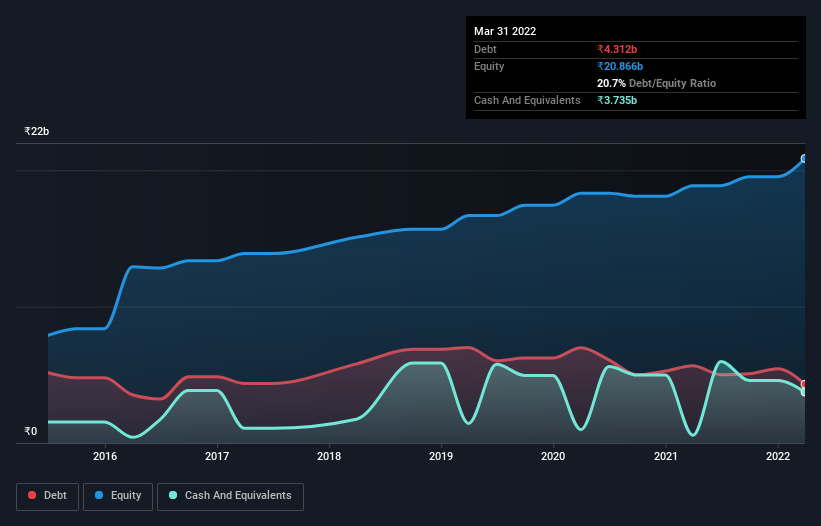- India
- /
- Construction
- /
- NSEI:JKIL
These 4 Measures Indicate That J. Kumar Infraprojects (NSE:JKIL) Is Using Debt Reasonably Well
Howard Marks put it nicely when he said that, rather than worrying about share price volatility, 'The possibility of permanent loss is the risk I worry about... and every practical investor I know worries about.' When we think about how risky a company is, we always like to look at its use of debt, since debt overload can lead to ruin. We note that J. Kumar Infraprojects Limited (NSE:JKIL) does have debt on its balance sheet. But is this debt a concern to shareholders?
When Is Debt A Problem?
Debt assists a business until the business has trouble paying it off, either with new capital or with free cash flow. In the worst case scenario, a company can go bankrupt if it cannot pay its creditors. However, a more frequent (but still costly) occurrence is where a company must issue shares at bargain-basement prices, permanently diluting shareholders, just to shore up its balance sheet. Of course, plenty of companies use debt to fund growth, without any negative consequences. When we think about a company's use of debt, we first look at cash and debt together.
See our latest analysis for J. Kumar Infraprojects
How Much Debt Does J. Kumar Infraprojects Carry?
The image below, which you can click on for greater detail, shows that J. Kumar Infraprojects had debt of ₹4.31b at the end of March 2022, a reduction from ₹5.66b over a year. However, it also had ₹3.74b in cash, and so its net debt is ₹577.0m.

How Strong Is J. Kumar Infraprojects' Balance Sheet?
The latest balance sheet data shows that J. Kumar Infraprojects had liabilities of ₹17.8b due within a year, and liabilities of ₹784.1m falling due after that. On the other hand, it had cash of ₹3.74b and ₹9.00b worth of receivables due within a year. So its liabilities outweigh the sum of its cash and (near-term) receivables by ₹5.83b.
This deficit isn't so bad because J. Kumar Infraprojects is worth ₹19.3b, and thus could probably raise enough capital to shore up its balance sheet, if the need arose. However, it is still worthwhile taking a close look at its ability to pay off debt.
We measure a company's debt load relative to its earnings power by looking at its net debt divided by its earnings before interest, tax, depreciation, and amortization (EBITDA) and by calculating how easily its earnings before interest and tax (EBIT) cover its interest expense (interest cover). Thus we consider debt relative to earnings both with and without depreciation and amortization expenses.
While J. Kumar Infraprojects's low debt to EBITDA ratio of 0.11 suggests only modest use of debt, the fact that EBIT only covered the interest expense by 3.6 times last year does give us pause. So we'd recommend keeping a close eye on the impact financing costs are having on the business. Pleasingly, J. Kumar Infraprojects is growing its EBIT faster than former Australian PM Bob Hawke downs a yard glass, boasting a 113% gain in the last twelve months. The balance sheet is clearly the area to focus on when you are analysing debt. But it is J. Kumar Infraprojects's earnings that will influence how the balance sheet holds up in the future. So if you're keen to discover more about its earnings, it might be worth checking out this graph of its long term earnings trend.
Finally, a company can only pay off debt with cold hard cash, not accounting profits. So we always check how much of that EBIT is translated into free cash flow. Over the most recent three years, J. Kumar Infraprojects recorded free cash flow worth 71% of its EBIT, which is around normal, given free cash flow excludes interest and tax. This cold hard cash means it can reduce its debt when it wants to.
Our View
Happily, J. Kumar Infraprojects's impressive EBIT growth rate implies it has the upper hand on its debt. But, on a more sombre note, we are a little concerned by its interest cover. Zooming out, J. Kumar Infraprojects seems to use debt quite reasonably; and that gets the nod from us. After all, sensible leverage can boost returns on equity. There's no doubt that we learn most about debt from the balance sheet. But ultimately, every company can contain risks that exist outside of the balance sheet. Case in point: We've spotted 2 warning signs for J. Kumar Infraprojects you should be aware of.
At the end of the day, it's often better to focus on companies that are free from net debt. You can access our special list of such companies (all with a track record of profit growth). It's free.
New: Manage All Your Stock Portfolios in One Place
We've created the ultimate portfolio companion for stock investors, and it's free.
• Connect an unlimited number of Portfolios and see your total in one currency
• Be alerted to new Warning Signs or Risks via email or mobile
• Track the Fair Value of your stocks
Have feedback on this article? Concerned about the content? Get in touch with us directly. Alternatively, email editorial-team (at) simplywallst.com.
This article by Simply Wall St is general in nature. We provide commentary based on historical data and analyst forecasts only using an unbiased methodology and our articles are not intended to be financial advice. It does not constitute a recommendation to buy or sell any stock, and does not take account of your objectives, or your financial situation. We aim to bring you long-term focused analysis driven by fundamental data. Note that our analysis may not factor in the latest price-sensitive company announcements or qualitative material. Simply Wall St has no position in any stocks mentioned.
About NSEI:JKIL
Flawless balance sheet, undervalued and pays a dividend.
Similar Companies
Market Insights
Community Narratives




